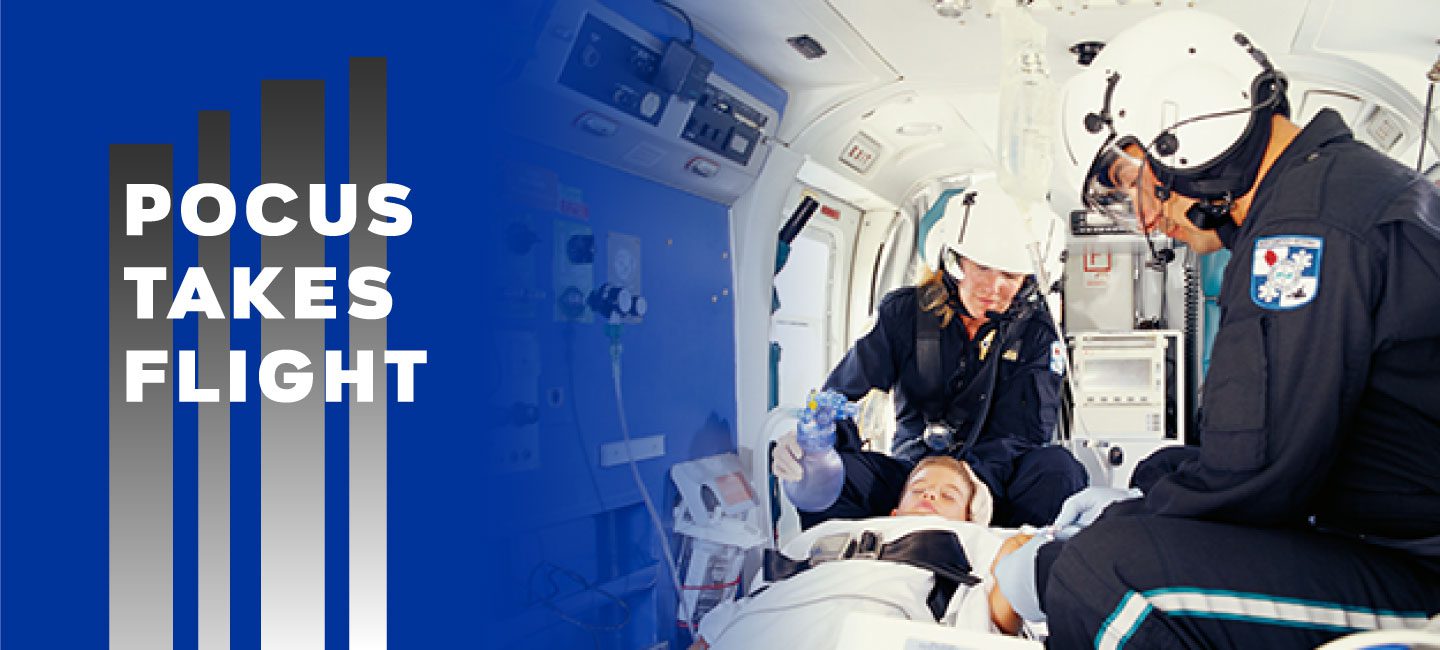Can you imagine your 15-month-old has been sick for two days, vomiting and unable to retain fluids? You’ve seen your local pediatrician who sent you to the emergency department with a staff of one. A treatment plan was implemented with anti-emetics, but your toddler’s condition is not improving. To make matters worse, living in a rural community prevents you from being able to get to the larger hospital in time to access the necessary treatment.

This gut-wrenching scenario happened to a family living in a remote community. Critical care air transport went to retrieve the child from the rural ED. During the one-hour flight, the patient experienced another episode of emesis and became tachycardiac. At this point, paramedics had administered three boluses of crystalloid.
Point-of-care ultrasound (POCUS) revealed the toddler had multiple bulging, fluid-filled loops in the small bowel, and fluid in the hepatorenal recess. Upon arrival at the hospital, surgeons immediately began focused scans because Phillips Lumify assisted the EMS in discovering the root of the issue. Doctors performed surgery, and four days later, the child returned home with the family for a happy ending.[1]
This inspiring story demonstrates POCUS at its best. This technology assisted the air medical personnel to pinpoint what was causing the symptoms in a time-efficient manner, which contributed to this child’s life being saved.
When patients experience life-threatening trauma, detecting the source in the early stages is crucial. According to a study called Aeromedical Ultrasound: The Evaluation of Point-of-care Ultrasound During Helicopter Transport, “Flight Crew POCUS examinations obtained a Positive Predictive Value of 100% and a Negative Predictive Value of 98.3% for the identification of pneumothorax, hemothorax, and free abdominal fluid, which is equivalent to that of the Trauma Team’s POCUS studies on the same group of patients.” Furthermore, iatrogenic injuries resulting from avoidable, invasive in-air procedures could be reduced by POCUS. While this study reveals evidence for the benefit of POCUS by helicopter EMS, researchers conclude that providing further research to support this application is a must.[2]
Pre-hospital POCUS is not only beneficial for diagnostic purposes but also aids in providing therapeutic and procedural actions. Generally, patients transported via air medical services require immediate and continual medical intervention. According to research, POCUS is beneficial to many different types of interventions, those being airway, breathing, circulation, disability (ischemic stroke), regional anesthesia, and disaster triage.[3] When aeromedical EMS is in a position to make the difference of life or death for a patient, POCUS is a pivotal tool that assists in that difference being made.
Thomas Hudson, NRP, CCP-C is a flight paramedic with Guardian Flight in Fairbanks, Alaska. He understands first-hand the positive impact POCUS is having in his field. Hudson says, “I think that we are seeing POCUS evolving more rapidly than any other EMS technology in the past, at least in the last 18 years I’ve been practicing.” Hudson understands the complexities of integrating POCUS into paramedics’ practice due to the skill set necessary to execute scans accurately and gives a call-to-action for more research on this specific application to continue this positive evolution. At the same time, he is also witnessing the great benefit that EMS is contributing when they’re able to use this life-saving technology in their work. Paramedics are making the transition from “algorithmic technicians” to highly skilled clinicians with a deeper, more robust knowledge of medicine. He attributes this growth to POCUS.[1]
Whether patients are in the air or on the ground, they want to know the medical attention they’re receiving is of the highest quality, based on standards of excellence. POCUS is facilitating that for aeromedical EMS. That is why continuing to build educational programs founded on expert research is so key to this technology’s evolvement in the medical space. One thing is for sure, we will continue to watch this device change the way we do medicine.
- March 30, 2017. Aeromedical Ultrasound: The Evaluation of Point-of-care Ultrasound During Helicopter Transport, Retrieved February 28, 2020, from https://doi.org/10.1016/j.amj.2017.02.001.
- August 8, 2018. ABCDE of prehospital ultrasonography: a narrative review, Retrieved February 28, 2020, from https://theultrasoundjournal.springeropen.com/articles/10.1186/s13089-018-0099-y.
- May 15, 2019. Trending: Expanded use of prehospital point of care ultrasound (P-POCUS), Retrieved February 28, 2020, from https://www.ems1.com/ems-products/defibrillators-and-monitors/articles/trending-expanded-use-of-prehospital-point-of-care-ultrasound-p-pocus-bUNvHKzLflX3RfyU/.
- September 20, 2019. POCUS during Air-medical transport of a critically ill child, Retrieved February 28, 2020, from https://www.youtube.com/watch?v=pfYtL0Kckew.
Looking for additional inspiration? Sign up for our POCUS Post™ newsletter to receive monthly tips and ideas.





















